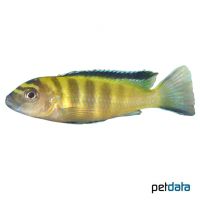Dinghani (Chindongo flavus)
| Dinghani Chindongo flavus | |
|---|---|
| Name | Dinghani |
| Name Lat. | Chindongo flavus |
| Synonym | Pseudotropheus flavus |
| Family | Cichlids |
| Family lat. | Cichlidae |
| Order | Cichlids |
| Order lat. | Cichliformes |
| Origin | Lake Malawi |
| Habitat | Rocky habitat |
| Diet | Omnivore, aufwuchs |
| pH | 7.5-8.8 |
| Behavior | Aggressive |
| Keeping | Harem |
| Care Level | Moderate |
| Reproduction | Mouthbrooder |
| Breeding | Simple |
| Life Span | 5-8 years |
| Protection | No |
| Metric Units | |
| Size | 8-10 cm |
| Temperature | 24-28 °C |
| Hardness | 10-25 °dH |
| Aquarium | ~ 300 l |
| US Units | |
| Size | 3"-4" |
| Temperature | 75-82 °F |
| Hardness | 178-445 ppm |
| Aquarium | ~ 80 gal |
Distribution and habitat
Yellow-striped narrowmouth bass are found exclusively (endemically) in Lake Malawi, near Chinyankwazi Island and a reef between Nankhumba Peninsula and Chinyamwezi Island (Mozambique). They belong to the Mbuna group, which lives in the rocky shore zones.
Maintenance
The aquarium setup should have rocky structures that reach the water surface, with plenty of crevices, caves and shelters to provide hiding places, as well as sturdy plants and some open sandy areas
There should be no detectable ammonia, ammonium or nitrite, and the nitrate level should not exceed 100 mg/l. To ensure the water quality and oxygen content, a filter and heater adapted to the aquarium size is required, as well as lighting for the species-appropriate day-night rhythm of the animals.
Diet
They feed mainly on the plant cover (growth) and the microorganisms contained therein, as well as on plankton. The food supply consists of live, frozen and dry food. For a balanced diet, feed once daily with a high-quality dry food for Malawi cichlids (flakes, granules, pellets) as well as cyclops, daphnia, artemia and plankton (live or frozen). In addition, they also need vegetable food, such as algae leaves and commercially available green food (kelp, spirulina)
Only feed as much as will be eaten within a few minutes. A regular and varied diet promotes health and increases resistance.
Behaviour and compatibility
Males occupy territories which they defend vigorously against conspecifics, they are not very aggressive towards other fish. They should be kept in a harem, one male with several females. Keeping multiple harems is only recommended in a larger and richly structured tank. They can be socialized well with other small cichlids from Lake Malawi, especially from the Mbuna group. Basically, only compatible fish species with similar demands on water condition and water temperature should be socialized.
Sex dimorphism
The males are more intensely colored than the females.
Reproduction and breeding
They are maternal mouth brooders. The female usually spawns on a flat rock. After the male fertilizes the eggs, she immediately takes the female into her throat pouch for mouth brood care and keeps the fry in her throat pouch even after hatching. After 3-4 weeks, the fry are released and brood care ends. Throughout brood care, the female does not consume food.
Fry must be fed several times a day with special rearing food (Artemia nauplii). In community tanks breeding is hardly possible, because the fry is easy prey.
Important
They should not be kept together with Pseudotropheus elongatus, as they can crossbreed and the males fight fiercely.
The well-being of the fish should be checked regularly. Temperature should be checked daily, pH, hardness and nitrate levels at least fortnightly. Regular partial water changes are recommended, even if the contaminant level has not yet reached the upper limit. Sudden changes in water quality should be avoided. Newly introduced fish must be accustomed slowly to the water in the aquarium.
Further literature can be found in your pet store.
References
Text: Sylvia Hos; Image: petdata
Source: BMELV (1998): Tierschutzgutachten - Haltung von Zierfischen (Süßwasser); BAENSCH & RIEHL (2004): Aquarien Atlas Bd. 4, Mergus Verlag; ENGELMANN (2005): Zootierhaltung - Tiere in menschlicher Obhut: Fische, Verlag Harri Deutsch
- Gemäß § 21 Abs. 5 Tierschutzgesetz idgF
